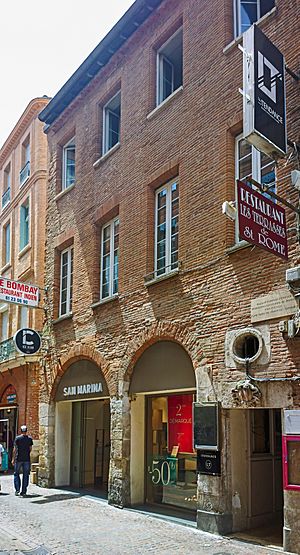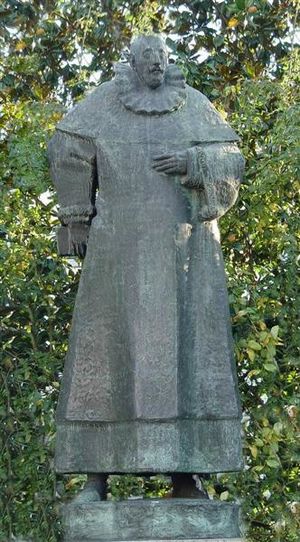Francisco Sanches facts for kids
Quick facts for kids
Francisco Sanches
|
|
|---|---|

Francisco Sanches
|
|
| Born | c. 1550 |
| Died | November 16, 1623 |
| Education | College of Guienne |
| Era | Renaissance philosophy |
| Region | Western philosophy |
| School | Renaissance skepticism |
| Institutions | University of Toulouse |
|
Notable ideas
|
"Nothing is known" |
|
Influences
|
|
|
Influenced
|
|
Francisco Sanches (c. 1550 – November 16, 1623) was a skeptic, philosopher and physician of Sephardi Jewish origin, born possibly in Tui, Spain or probably in Braga, Portugal (where he was baptized and grew up).
Early life and academic career
In the auditorium of the University of Toulouse there is a portrait of Francisco Sánchez, which bears the following inscription: "Francisco Sanchez Lusitanus". Although the investigations carried out by Henry Pierre Cazac at the beginning of the 20th century – he presented, among other documents, an autograph by Sánchez that reads as follows: "Ego, Franciscus Sanctius, Hispanus, natus in civitate Tudensi [...]" – showed the Spanish origin of Francisco Sánchez, there has been a long controversy around his nationality, as shown in the title of some publications that try to ascribe the name of the illustrious doctor and philosopher to the French Renaissance (The Skeptics of the French Renaissance, by John Owen) or Portuguese (Francisco Sanches ea dúvida methodica na Renascença portuguesa, doctoral thesis by Evaristo de Moraes Filho). His father was the Spaniard Antonio Sanches, also a physician; his mother Filipa de Sousa was Portuguese. Being of Jewish origin, even if converted, he was legally considered a New Christian.
He studied in Braga until the age of 12, when he moved to Bordeaux with his parents, fleeing the surveillance of the Portuguese Inquisition. There he resumed his studies at the College de Guyenne. He went on to study medicine in Rome in 1569, and, back in France, in Montpellier and Toulouse. He ended up, after 1575, as a professor of philosophy and medicine at the University of Toulouse.
Main work and thought

In his Quod nihil scitur (That Nothing Is Known), written in 1576 and published in 1581, he used the classical skeptical arguments to show that science, in the Aristotelian sense of giving necessary reasons or causes for the behavior of nature, cannot be attained: the search for causes quickly descends into an infinite regress and so cannot give certitude. He also attacked demonstrations in the forms of syllogisms, arguing that the particular (the conclusion) is needed to have a conception of the general (the premises) and thus that syllogisms were circular and did not add to knowledge.

Perfect knowledge, if attainable, is the intuitive apprehension of each individual thing. But, he then argued, even his own notion of science (perfect knowledge of an individual thing) is beyond human capabilities because of the nature of objects and the nature of man. The interrelation of objects, their unlimited number, and their ever-changing character prevent their being known. The limitations and variability of man's senses restrict him to knowledge of appearances, never of real substances. In forming these last argument he drew on his experience of Medicine to show how unreliable our sense experience is.
Sanches' first conclusion was the usual fideistic one of the time, that truth can be gained by faith. His second conclusion was to play an important role in later thought: just because nothing can be known in an ultimate sense, we should not abandon all attempts at knowledge but should try to gain what knowledge we can, namely, limited, imperfect knowledge of some of those things with which we become acquainted through observation, experience, and judgment. The realization that nihil scitur ("nothing is known") thus can yield some constructive results. This early formulation of "constructive" or "mitigated" skepticism was to be developed into an important explication of the new science by Marin Mersenne, Pierre Gassendi, and the leaders of the Royal Society.

Works
- Carmen de Cometa, 1577.
- Quod nihil scitur, 1581.
- De divinatione per somnum, ad Aristotelem, 1585.
- Opera Medica, 1636, which includes:
- De Longitudine et Brevitate vitae, liber
- In lib. Aristotelis Physiognomicon, Commentarius
- De Divinatione per Somnum
- Quod Nihil Scitur, liber
- Tractatus Philosophici, 1649.
Translations
- – Latin-German. Introduction and Notes by Kaspar Howald. Translated by Damian Caluori and Kaspar Howald. Latin Text by Sergei Mariev. PhB 586. 2007.
- – Critical edition of Quod nihil scitur.
- .
- Sánchez, Francisco. 1991, Que nada se sabe. Introduction: Palacios, Fernando A. Spanish translation, Espasa Calpe, Madrid. ISBN: 9788423972357
See also
 In Spanish: Francisco Sánchez el Escéptico para niños
In Spanish: Francisco Sánchez el Escéptico para niños

